Tuesday, December 4, 2007
Using Google Architecturally
1. Google Search
Google now searches Microsoft Office, PostScript, Corel WordPerfect, Lotus 1-2-3, and others. The new file types will simply appear in Google search results whenever they are relevant to the user query. For example, if you’re looking for the Door Detailing in AutoCAD DWG format, key in door detail filetype:dwg
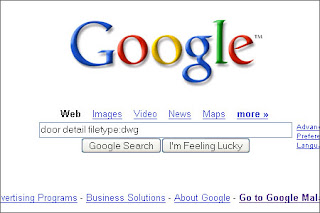 The image above is an example of how it should be done, it need not be door detail filetype:dwg, if you prefer to see a particular set of results with a specific file type (for example, PDF links), simply type filetype:[extension] (for example, filetype:pdf) within the search box along with your search term(s).
The image above is an example of how it should be done, it need not be door detail filetype:dwg, if you prefer to see a particular set of results with a specific file type (for example, PDF links), simply type filetype:[extension] (for example, filetype:pdf) within the search box along with your search term(s).
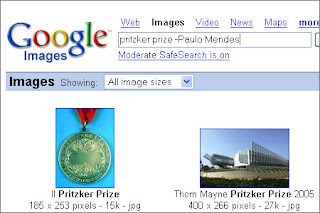 Another unique feature found in Google is the exclusion ability of certain keywords when searching. For example if you’re looking for Pritzker Prize, chances are Paulo Mendes da Rocha from Barzil will top the list simply because he is the winner of the prestgeous award for 2006.
Another unique feature found in Google is the exclusion ability of certain keywords when searching. For example if you’re looking for Pritzker Prize, chances are Paulo Mendes da Rocha from Barzil will top the list simply because he is the winner of the prestgeous award for 2006.
To exclude him from the search results, key in “Pritzker Prize -Paulo Mendes” and Mr.Mendes will not be found in the search results. This feature is useful when you’re searching for certain context that seems to return irrelevant results.
2. Google Translate
French words are romantic, music to the ears and the best part is not many people understand the language, let alone speak, which makes it exotic.
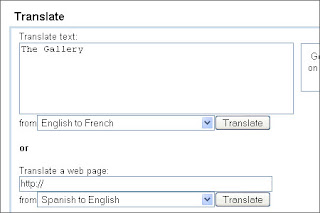 Try Google Translate, for example if you’re given the task to name the newly proposed show unit, key in The Gallery in Google Translate.
Try Google Translate, for example if you’re given the task to name the newly proposed show unit, key in The Gallery in Google Translate.
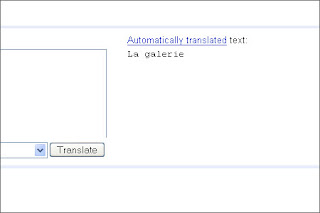 There you go, it is La galerie and isn’t it much better than the English term “The Gallery’? There are other alternatives besides French, Spanish and Italian terms are kind of interesting too.
There you go, it is La galerie and isn’t it much better than the English term “The Gallery’? There are other alternatives besides French, Spanish and Italian terms are kind of interesting too.
3. Google Calculator
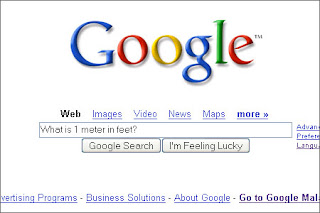
 To use Google’s built-in calculator function, simply enter the calculation you’d like done into the search box and hit the Enter key or click on the Google Search button. The calculator can solve math problems involving basic arithmetic, more complicated math, units of measure and conversions, and physical constants.
To use Google’s built-in calculator function, simply enter the calculation you’d like done into the search box and hit the Enter key or click on the Google Search button. The calculator can solve math problems involving basic arithmetic, more complicated math, units of measure and conversions, and physical constants.
These sample queries demonstrate the utility and power of this new feature:
4. Google Sketchup and Google Earth
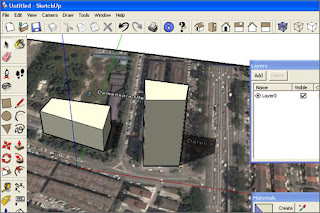 Sun study in an important part of architecture, a good building orientation will greatly reduce the need for mechanical ventilation, combination of Google Sketchup and Google Earth gives the end user the ability to determine the sun angle thru out the year.
Sun study in an important part of architecture, a good building orientation will greatly reduce the need for mechanical ventilation, combination of Google Sketchup and Google Earth gives the end user the ability to determine the sun angle thru out the year.
1. Snap pictures of the surrounding buildings.
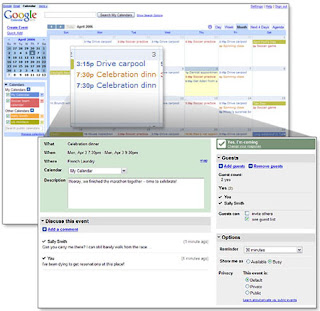
Google now searches Microsoft Office, PostScript, Corel WordPerfect, Lotus 1-2-3, and others. The new file types will simply appear in Google search results whenever they are relevant to the user query. For example, if you’re looking for the Door Detailing in AutoCAD DWG format, key in door detail filetype:dwg
 The image above is an example of how it should be done, it need not be door detail filetype:dwg, if you prefer to see a particular set of results with a specific file type (for example, PDF links), simply type filetype:[extension] (for example, filetype:pdf) within the search box along with your search term(s).
The image above is an example of how it should be done, it need not be door detail filetype:dwg, if you prefer to see a particular set of results with a specific file type (for example, PDF links), simply type filetype:[extension] (for example, filetype:pdf) within the search box along with your search term(s).To exclude him from the search results, key in “Pritzker Prize -Paulo Mendes” and Mr.Mendes will not be found in the search results. This feature is useful when you’re searching for certain context that seems to return irrelevant results.
2. Google Translate
This is one of the best tools by Google. Assuming that you’ve just completed your architectural project and to wrap it up you need a name, something catchy and striking. We all know that English term are over used, I’m not saying that English terms are boring, just that it gives an impression of formality.
French words are romantic, music to the ears and the best part is not many people understand the language, let alone speak, which makes it exotic.
 Try Google Translate, for example if you’re given the task to name the newly proposed show unit, key in The Gallery in Google Translate.
Try Google Translate, for example if you’re given the task to name the newly proposed show unit, key in The Gallery in Google Translate. There you go, it is La galerie and isn’t it much better than the English term “The Gallery’? There are other alternatives besides French, Spanish and Italian terms are kind of interesting too.
There you go, it is La galerie and isn’t it much better than the English term “The Gallery’? There are other alternatives besides French, Spanish and Italian terms are kind of interesting too.3. Google Calculator
The Pandora box of Google Search, if you happen to be a lazy fellow like me with problems memorizing those magical numbers, converting one units to another is now as easy as 123.
What is 1 meter in feet? Simply ask Google.
What is 1 meter in feet? Simply ask Google.

 To use Google’s built-in calculator function, simply enter the calculation you’d like done into the search box and hit the Enter key or click on the Google Search button. The calculator can solve math problems involving basic arithmetic, more complicated math, units of measure and conversions, and physical constants.
To use Google’s built-in calculator function, simply enter the calculation you’d like done into the search box and hit the Enter key or click on the Google Search button. The calculator can solve math problems involving basic arithmetic, more complicated math, units of measure and conversions, and physical constants.These sample queries demonstrate the utility and power of this new feature:
• 5+2*2
• 2^20
• sqrt(-4)
4. Google Sketchup and Google Earth
 Sun study in an important part of architecture, a good building orientation will greatly reduce the need for mechanical ventilation, combination of Google Sketchup and Google Earth gives the end user the ability to determine the sun angle thru out the year.
Sun study in an important part of architecture, a good building orientation will greatly reduce the need for mechanical ventilation, combination of Google Sketchup and Google Earth gives the end user the ability to determine the sun angle thru out the year.1. Snap pictures of the surrounding buildings.
2. Save a screenshot of the zoom in area in Google Earth
3. Import the Google Earth image into Google Sketchup
4. Start drawing the existing building accordingly.
5. Enable shadow to study the sun orientation.
5. Google Calendar
This new feature from Google allows you to organize your daily routine for free, with today’s unlimited broadband, Google Calendar can be a reminder of deadlines for ongoing projects and of course friends and family’s birthday.
This new feature from Google allows you to organize your daily routine for free, with today’s unlimited broadband, Google Calendar can be a reminder of deadlines for ongoing projects and of course friends and family’s birthday.

6. Google Docs and Spreadsheets
Create and share your projects online and access them from anywhere. You may have a pendrive but certain Colleges and Universities don’t allow pendrive for fear of virus. Anyway, what you need to do is type your report with this online Docs (alternative to Microsoft Word) and Spreadsheets (alternative to Microsoft Excel) and save it online. If I’m a lecturer, I’ll definitely force my students to compile their report with Google Docs, no more excuses such as forgot to bring my pendrive or the computer in the labs couldn’t read my pendrive.
Create and share your projects online and access them from anywhere. You may have a pendrive but certain Colleges and Universities don’t allow pendrive for fear of virus. Anyway, what you need to do is type your report with this online Docs (alternative to Microsoft Word) and Spreadsheets (alternative to Microsoft Excel) and save it online. If I’m a lecturer, I’ll definitely force my students to compile their report with Google Docs, no more excuses such as forgot to bring my pendrive or the computer in the labs couldn’t read my pendrive.
7. Google Scholar
Stand on the shoulders of giants. Google Scholar is the best place to search for information. Remember, copy from one is plagiarism, copy from two is research.
Google Scholar provides a simple way to broadly search for scholarly literature. From one place, you can search across many disciplines and sources: peer-reviewed papers, theses, books, abstracts and articles, from academic publishers, professional societies, preprint repositories, universities and other scholarly organizations. Google Scholar helps you identify the most relevant research across the world of scholarly research.
8. Google Base
This is the place where you go when you’re desperate. It is suppose to be the next ebay, unlike ebay which do not permit selling of services or non-physical goods, Google Base actually encourage this non-physical services. If you need a 3D rendering to be completed before the end of the week then try Google Base, search for these freelance.
Autocad 2008 tips & tricks
A link to autocad2008 tips & tricks you can't afford to miss.It is improvement everyday~!
"Getting to BIM – an implementation outlineThis featured article by Scott Hammond, technical marketing manager for structural engineering solutions at Autodesk, looks at the process of implementing BIM into a firm. The article provides an implementation plan outline, including beginning with a pilot project and a core BIM team at the onset of implementation.
Tips and Techniques
Tip 1: BIM Do's and Dont's – essential steps for successful implementation and common pitfalls to avoid
This quick checklist is put together by Beau Turner and Joe Eichenseer, 2 BIM professionals from the Avatech Building Solutions Group and regular contributors to Cadalyst.
Tip 2: More effective rendering using better lighting effects
This handy tip was provided by Justin Taylor, a South African contributor to the AUGI User Forums and Revitup site.
Tip 3: Lynn Allen’s AutoCAD 2008 Tips & Tricks
Experience more speed, ease and accuracy than ever before with these insider Tips & Tricks from AutoCAD® guru Lynn Allen. This informational screencast will show you how to propel day-to-day drafting forward with intelligent tools and features, and get on the fast track to productivity and success! "
"Getting to BIM – an implementation outlineThis featured article by Scott Hammond, technical marketing manager for structural engineering solutions at Autodesk, looks at the process of implementing BIM into a firm. The article provides an implementation plan outline, including beginning with a pilot project and a core BIM team at the onset of implementation.
Tips and Techniques
Tip 1: BIM Do's and Dont's – essential steps for successful implementation and common pitfalls to avoid
This quick checklist is put together by Beau Turner and Joe Eichenseer, 2 BIM professionals from the Avatech Building Solutions Group and regular contributors to Cadalyst.
Tip 2: More effective rendering using better lighting effects
This handy tip was provided by Justin Taylor, a South African contributor to the AUGI User Forums and Revitup site.
Tip 3: Lynn Allen’s AutoCAD 2008 Tips & Tricks
Experience more speed, ease and accuracy than ever before with these insider Tips & Tricks from AutoCAD® guru Lynn Allen. This informational screencast will show you how to propel day-to-day drafting forward with intelligent tools and features, and get on the fast track to productivity and success! "
Alternative Design Software. Open Source Architect
What has happened to our tools?
First, the software market tends to monopoly. Since the acquisition of Macromedia (Flash, Freehand) Adobe dominates the design software market. Even some of the major 3D software packages are in one hand: Autodesk, the producer of AutoCAD and 3D Studio Max, has bought Alias and now owns Maya and other 3d applications. Not to mention the monopoly of Microsoft.Secondly, software cost easily burst the budget of small architecture firms. What can be done if you do not want to use illegal software?
So it's time to look for some alternatives: open source software. See the brief summary of some recommendable open source applications. Of course this list is not exhaustive! Regrettably it's hard to find an alternative to commercial 2D drafting programs...
Scribus
an open-source desktop publsihing program, supports professional publishing features, such as CMYK color, separations, ICC color management and PDF creation. Scribus is an alternative to commercial software like Quark or Indesign.http://www.scribus.net/
Inkscape
an Open Source vector graphics editor like Illustrator or Freehand.http://www.inkscape.org
Blender
an open source software for 3D modeling, animation and rendering.http://www.blender.org
Paint.Net
an image and photo manipulation software. It supports layers, unlimited undo, special effects, and a wide variety of useful and powerful tools.http://www.eecs.wsu.edu/paint.net/
Gimp
an image and photo manipulation software.http://www.gimp.org/
OpenOffice
a multiplatform and multilingual office suite, compatible with all other major products.www.openoffice.org/
PDFCreator
creates PDFs from any Windows program.http://sourceforge.net/projects/pdfcreator/
First, the software market tends to monopoly. Since the acquisition of Macromedia (Flash, Freehand) Adobe dominates the design software market. Even some of the major 3D software packages are in one hand: Autodesk, the producer of AutoCAD and 3D Studio Max, has bought Alias and now owns Maya and other 3d applications. Not to mention the monopoly of Microsoft.Secondly, software cost easily burst the budget of small architecture firms. What can be done if you do not want to use illegal software?
So it's time to look for some alternatives: open source software. See the brief summary of some recommendable open source applications. Of course this list is not exhaustive! Regrettably it's hard to find an alternative to commercial 2D drafting programs...
Scribus
an open-source desktop publsihing program, supports professional publishing features, such as CMYK color, separations, ICC color management and PDF creation. Scribus is an alternative to commercial software like Quark or Indesign.http://www.scribus.net/
Inkscape
an Open Source vector graphics editor like Illustrator or Freehand.http://www.inkscape.org
Blender
an open source software for 3D modeling, animation and rendering.http://www.blender.org
Paint.Net
an image and photo manipulation software. It supports layers, unlimited undo, special effects, and a wide variety of useful and powerful tools.http://www.eecs.wsu.edu/paint.net/
Gimp
an image and photo manipulation software.http://www.gimp.org/
OpenOffice
a multiplatform and multilingual office suite, compatible with all other major products.www.openoffice.org/
PDFCreator
creates PDFs from any Windows program.http://sourceforge.net/projects/pdfcreator/
Terrace House, France
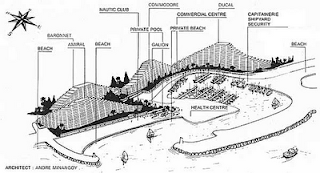
Providing open space is a fundamental quality in the design of multi story apartment buildings: the possibility to leave the flat while still being in the private realm. It's solvable by a mix of loggias, balconies and terraces. The Marina Baie des Anges between Nice and Cannes at Villeneuve Loubet, France (built 1969 - 1993) is an impressive example for a pyramid-shaped terrace-house typology.
Postcard of the Marina Baie des Anges between Nice and Cannes at Villeneuve Loubet.
It's a 70m high multipurpose condo (apartments from studio to penthouse, permanent flats and vacation rental), parking, commercial centre, sport club, yacht harbour, health centre, etc.
Starchitect's Movies

Documentarists have discovered starchitects. From Frank Gehry, to Norman Foster and recently (by a Swiss filmmaker) to Calatrava. Hopefully, films with an happy end.
Work Life Balance
Generally, in architectural practises, office hours get stretched a little bit. Not only for junior ranks or interns during peak periods – it’s common. You know - architectural practices have a lot of hour-sucking work. Funny enough, architects are often proud of that.
Being surrounded mostly by colleagues younger than thirty might be a good indicator for an office with a bad work life balance policy. People tend to leave these kind of places when they get older and switch to a firm that reflects their demands for life: spend time with family and kids, develop new interests, learning a language, charity work, ...
I don't mind hard work – but it's important to have a life outside the office. Architects have to give their clients an optimistic outlook to something new. How should they do that if they’re just staying in the office?
In many architectural practices employees hardly have any influence whether or not they have to do overtime work. If you got a deadline, people naturally expect you to stay (overnight). Have you ever done a design competition without night shifts? Especially in small architectural practices there is usually no possibility of refusing overtime work. Yet, in some cases you would get the office in big troubles (and you wouldn’t be a good colleague). Stupidly, many employees in architectural offices don’t even get any extra financial compensation for overtime.These are elements of employees’ weak "time-sovereignty" which strongly affects the work-life balance. Unfortunately it’s part of the architect’s working culture.
Being surrounded mostly by colleagues younger than thirty might be a good indicator for an office with a bad work life balance policy. People tend to leave these kind of places when they get older and switch to a firm that reflects their demands for life: spend time with family and kids, develop new interests, learning a language, charity work, ...
I don't mind hard work – but it's important to have a life outside the office. Architects have to give their clients an optimistic outlook to something new. How should they do that if they’re just staying in the office?
In many architectural practices employees hardly have any influence whether or not they have to do overtime work. If you got a deadline, people naturally expect you to stay (overnight). Have you ever done a design competition without night shifts? Especially in small architectural practices there is usually no possibility of refusing overtime work. Yet, in some cases you would get the office in big troubles (and you wouldn’t be a good colleague). Stupidly, many employees in architectural offices don’t even get any extra financial compensation for overtime.These are elements of employees’ weak "time-sovereignty" which strongly affects the work-life balance. Unfortunately it’s part of the architect’s working culture.
Subscribe to:
Comments (Atom)







